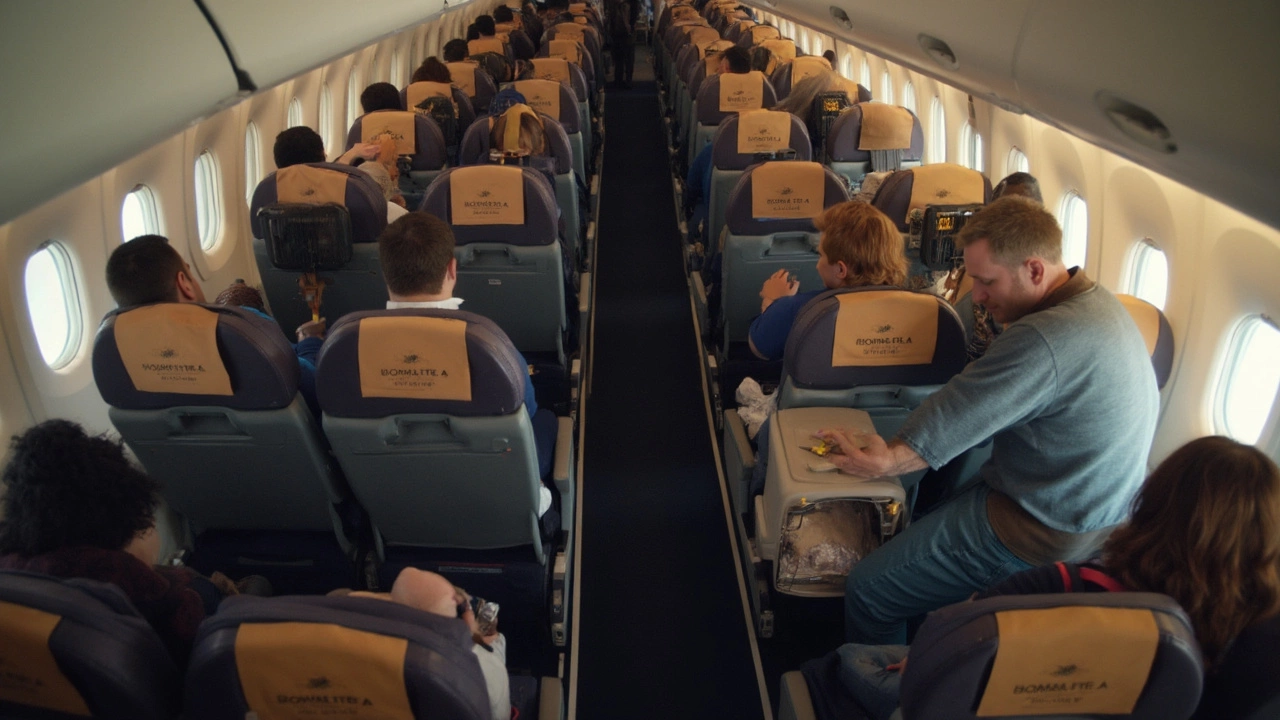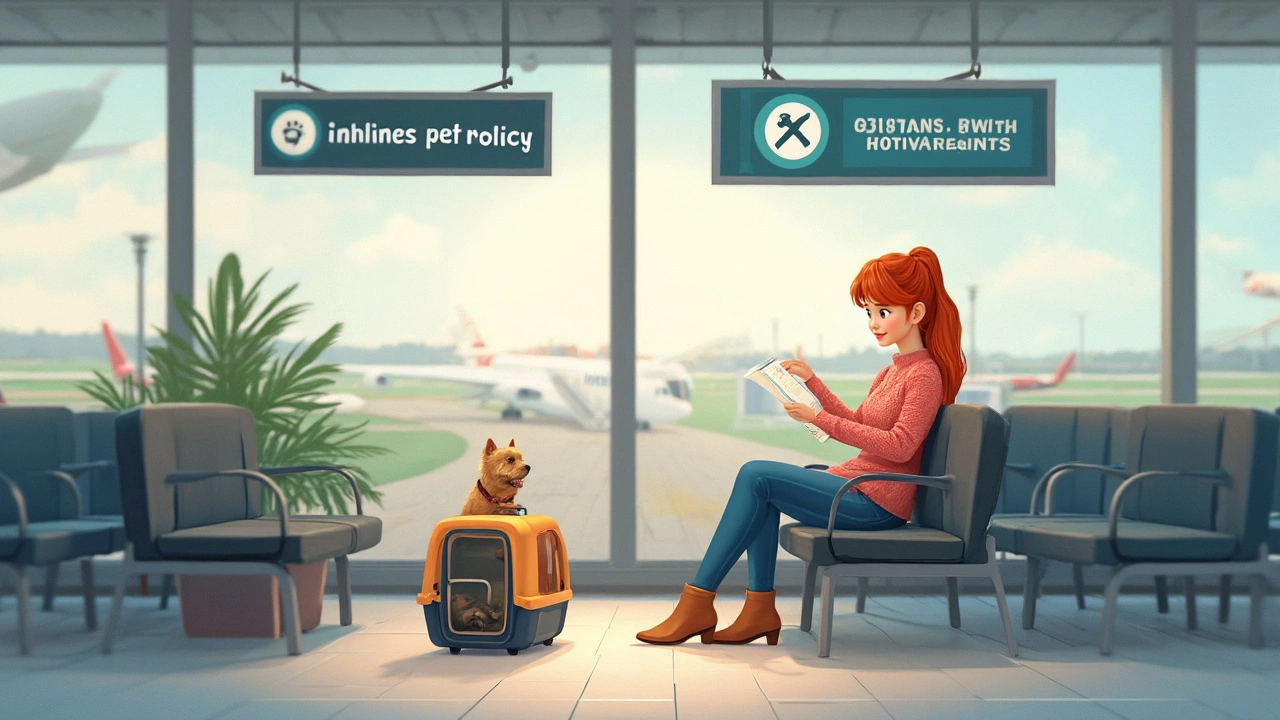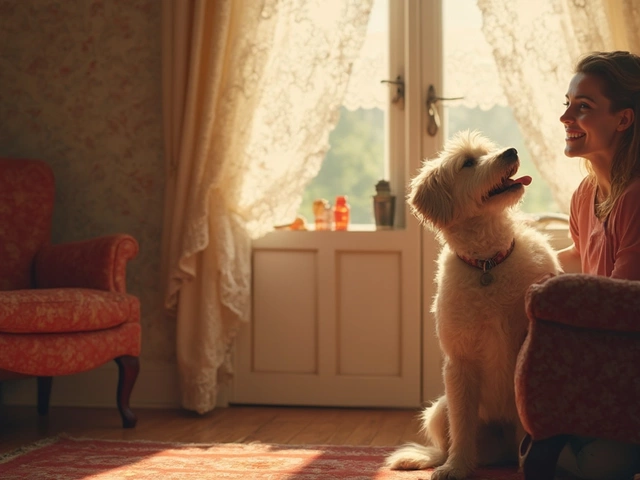Picture this: you finally get settled in your tiny airplane seat, your carrier with a nervous pup or kitten in your hands. Instinct says keep them close—on your lap if you can. But here comes the cabin crew, politely (or not) telling you to slide the carrier under the seat in front. Why the fuss?
Most airlines are super strict about where you stash your pet’s carrier during a flight. In almost every case, you can't just pop it on your lap, no matter how well-behaved your pet is. It’s all down to safety rules. The space under the seat is designed to keep things secure. During takeoff, landing, and turbulence, anything loose—like a wobbly pet carrier—can become a hazard.
The thing is, airline staff have seen all sorts of emergencies. When things go sideways, having the aisle and your lap clear matters. So even if your furry mate is calm as anything, you’ll still need to stick to the under-seat rule. Knowing this upfront can save you a heap of stress (and some blunt words from your flight attendant).
- Why Airlines Care Where You Put Your Pet Carrier
- Standard Pet Carrier Rules on Planes
- Exceptions and Special Cases
- Tips for Keeping Your Pet Comfortable
- Must-Know Advice Before You Fly
Why Airlines Care Where You Put Your Pet Carrier
On a plane, rules about where you put your pet carrier aren't just to annoy you—they're actually about passenger safety. When you fly, every bit of carry-on has to be secured, especially during takeoff and landing. This isn't just about clutter—airline safety regulations set by authorities like the UK Civil Aviation Authority (CAA) or the FAA in the US require aisles and laps to be clear, so nothing can block an emergency exit or fly around if the plane hits turbulence.
The space under your seat is designed to hold bags and pet carriers securely. If there’s a sudden jolt or you need to get out fast, having a loose carrier on your lap could trip you or someone else up—or worse, get tossed around. Flight attendants spot these risks right away, so they rarely allow exceptions for emotional or sentimental reasons.
Airlines got these rules after seeing what can happen when stuff isn’t put away. For example, the FAA reported that loose items are a top reason for injuries during turbulence. Each year, dozens of people get hurt by flying laptops, coffee mugs, or yes—pet carriers. That’s why staff are pushy about keeping your pet carrier under the seat, not on your knees or in the aisle.
Here's a quick breakdown of why the under-seat spot is non-negotiable:
- It keeps aisles and escape paths clear in case of an evacuation.
- It stops the carrier from becoming a projectile during rough air.
- It frees up your hands and lap for your own safety and comfort.
Simply put, pet travel on a plane means playing by these exact safety standards, no matter how small, cute, or sleepy your animal is.
Standard Pet Carrier Rules on Planes
If you’re flying with your pet in the cabin, every airline sets a strict list of rules, so there's no getting creative with your pet carrier. The biggest one is where your carrier goes: under the seat in front of you. That’s non-negotiable for all the big names like British Airways, Delta, American, and Lufthansa. If your pet’s too big to fit under there, it’s cargo—no exceptions.
The flight rules get pretty specific. Your pet carrier must be soft-sided, ventilated, and able to completely close. The usual size limit hovers around 18 x 11 x 11 inches (45 x 28 x 28 cm), but always double-check with your airline because some charge extra if the bag’s even a smidge too large. Weight matters too, with most airlines capping the total (pet and carrier) at 8kg to 10kg (17-22 lbs).
| Airline | Max Carrier Size (cm) | Weight Limit |
|---|---|---|
| British Airways | 45 x 30 x 24 | 8kg |
| Delta | 46 x 28 x 28 | Varies, check each route |
| Air France | 46 x 28 x 24 | 8kg |
Getting up during the flight? You can check on your pet, but the cabin regulations mean you can't open the carrier or place it on your lap during takeoff, landing, or turbulence. If you try to sneak your pet out or set the bag in the aisle, you’re risking a fine or even getting barred from flying with that airline again.
A couple more must-haves: line the carrier with absorbent material and make sure your pet can stand up, turn, and lie down. Be ready to show your carrier at check-in and, on most flights, pay a fee—this usually ranges between £35 and £150 each way, depending on the destination.

Exceptions and Special Cases
Wondering if there’s ever a time when your pet carrier gets to ride on your lap during a flight? Here’s the scoop: exceptions are rare, but there are a few.
The most common exception is for emotional support animals (ESAs) and service animals, but here’s the catch—rules have changed big time since 2021. Most airlines now say only trained service dogs (not ESAs) can sit at their owner’s feet or lap, and that’s without a pet carrier at all. Your guinea pig or teacup Yorkie in a carrier? Still has to stay under the seat.
International flights often stick tighter to these cabin regulations. Some smaller regional airlines in remote locations (think tiny planes flying to Scottish islands) might be more chill, but even then, it’s cabin crew who get the final say.
If you have medical needs, some airlines let you keep medical devices or support animals with you, but again, a pet carrier is seen as baggage, not a medical device—so lap privileges don’t really apply.
For people flying private or charter planes, things are way more relaxed. If you’re the only passenger, no one’s going to tell you off for letting your pet sit on your lap—carrier or no carrier. But let's be real, most of us aren’t chartering jets every holiday.
The bottom line? Unless you have a trained service dog or you’re on a totally private aircraft, plan on your carrier staying under the seat. And if you ever want to double-check, here’s what some major airlines say:
- British Airways: No pets in cabin, except assistance dogs.
- EasyJet and Ryanair: No pets in cabin at all.
- Delta and United: Pets in carriers under the seat, service dogs only can be out.
- Air Canada: Small pets in carriers under the seat—no laps.
You can sometimes find this info buried in the airline’s pet policy page, but it’s easier to call ahead or tweet at customer service for a direct answer. Saves time, hassle, and awkward arguments with crew.
Tips for Keeping Your Pet Comfortable
Alright, so you’ve got the pet carrier sorted and the rules down, but let’s talk about your pet’s actual comfort on that cramped flight. Nobody wants a stressed-out animal, especially in a stuffy cabin. There are a few key things you can do that really make a difference.
- Let your pet get used to the carrier early. Leave the pet carrier out at home a couple of weeks before you fly. Drop treats or a favourite blanket inside so it feels safe and familiar. Pets hate surprises just as much as we do.
- Pick the right size. Your pet should be able to stand, turn around, and lie down comfortably. Don’t try to squeeze a big cat into a tiny bag—airline staff check for this, and your animal will thank you for the extra room.
- Watch the food and water. Don't feed your pet right before the flight—about four hours beforehand is a good cut-off, because a full stomach can mean motion sickness. Still, keep them hydrated, especially if you’re flying a long way. You can freeze water in a small dish so it won’t spill by accident but will melt as they need it.
- Line the bottom of the carrier. Use absorbent pads just in case there’s an accident. Cabin pressure and stress sometimes mess with a pet’s tummy, and it’s better safe than sorry.
- Pack familiar smells. A well-loved toy or blanket helps a ton. Familiar scents work better than anything at keeping pets chill in new places.
Here's a quick look at how these basic tricks can help, taken from a UK pet travel survey with pet owners who flew at least once last year:
| Tip Used | Pets Showed Less Anxiety |
|---|---|
| Carrier training ahead of flight | 85% |
| Bringing familiar bedding | 72% |
| No feeding 4 hours before | 65% |
Noise can be scary, too. Noise-cancelling covers or even just draping a light blanket over part of the carrier can help make things quieter. If the flight is long, check with your vet first—some pets do well with a calming spray or a natural anxiety remedy, but you want expert advice before trying anything new.
One last thing: fasten the pet carrier securely under the seat, but make sure there’s still airflow on at least three sides. Unzipping the top just a crack for a bit of a hand rub (when the crew isn’t looking) can work wonders, too. Just make sure your buddy can’t wriggle out.

Must-Know Advice Before You Fly
Flying with your pet isn’t just about picking the cutest pet carrier—there’s real prep work if you want things to go smoothly. Here’s a list of important steps and facts you shouldn’t skip, even if you’ve done it all before.
- Check your airline’s pet policy. No two airlines handle pet travel the same way. Some cap the number of pets in the cabin, others ban certain breeds. Budget airlines can have even stricter rules. Always double-check right on their website, don’t rely on what you heard from a friend.
- Book your pet’s spot early. Most flights only let a few pets in the cabin. If you wait, all the spots might be gone and you’ll be stuck.
- Carrier size matters. Your pet carrier has to fit under the seat in front of you or you won’t get it on board. Bring a soft-sided carrier for a little flexibility—hard cases often don’t squeeze in.
- Visit your vet. Some airlines ask for recent health certificates or proof of vaccinations. Even if they don’t, a quick checkup before flying makes life easier if a staff member starts asking questions at the gate.
- Know the paperwork for international flights. Leaving the UK with your pet? Countries like Australia and the USA have strict rules and may require microchips, rabies tests, or quarantine time. Start this process months ahead.
- Arrive early at the airport. Security and check-in can take longer. Having a pet with you means extra forms and more questions from staff.
- Prep your pet for the carrier. Get them used to it at home—not just the night before. Toss treats in, let them sleep there, and take them on short car rides in the carrier.
- Pack essentials. You’ll want a collapsible water bowl, a little food, a favourite toy, poo bags, and maybe puppy pads for long flights or delays.
Fun fact: According to Heathrow’s official stats from 2024, over 16,000 pets traveled through London airports last year, and nearly 20% of people got delayed at check-in over missing or incomplete pet documents. Double-checking things can save serious headache at the airport.
If you’re not sure about any rule or your pet’s situation is a bit unusual, give the airline a call or email. They see all sorts of questions and are used to handling nervous owners. Better a five-minute call than being refused at boarding when you finally reach the desk.







